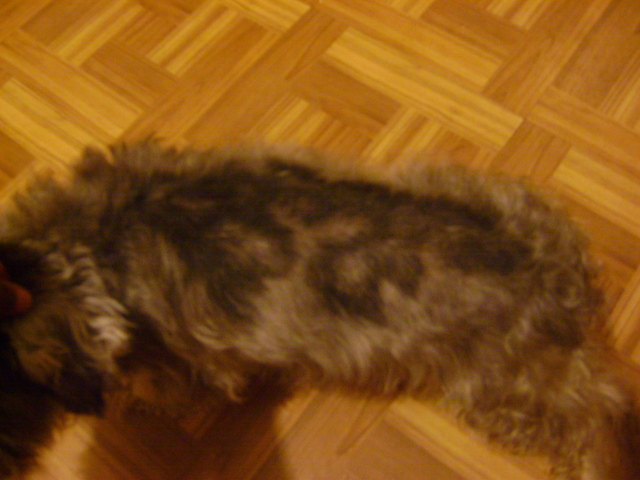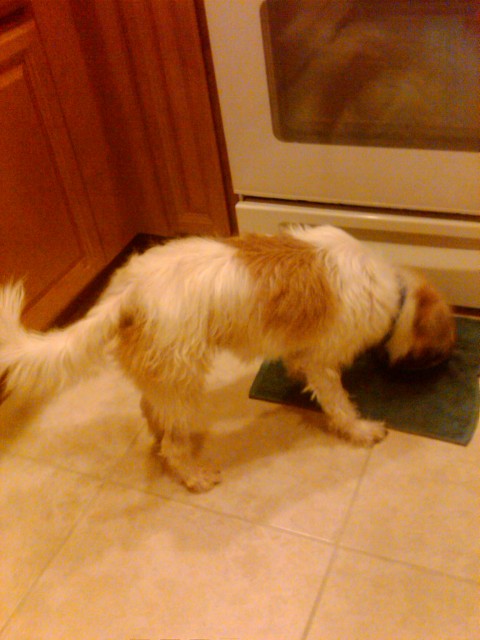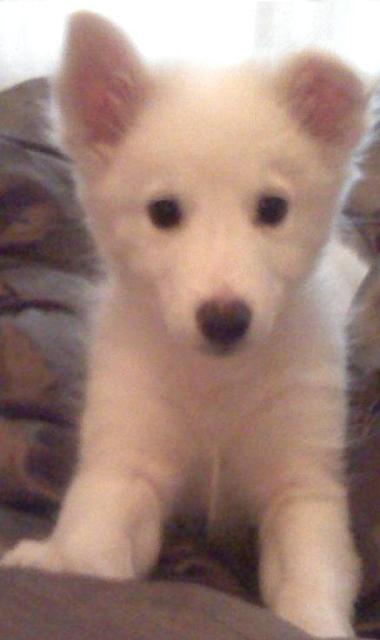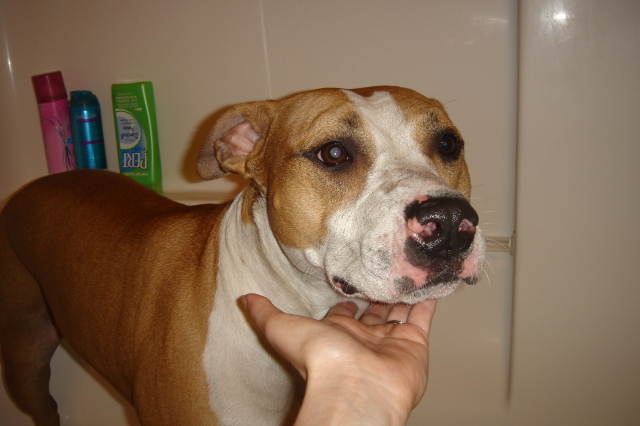QuestionMy 3-yr. old spayed female Boxer began to develop in the last couple of years an agression toward other dogs. The trigger situation - which has become 100% predictable - is when we are walking and she is, of course, on the lead and sees another dog. The other dog can be across the street or even further away and she starts lunging and barking. When the problem was at its worst, Gracie would turn on me and start attacking me, both with her paws (Boxer-style) and with her mouth. She had never bitten or shown aggression toward me or any other person while inside of my home still never does (inside). She only shows this agression when in the trigger situation. This problem became so bad at one point that I had to force myself to take her for walks but dreaded every minute of it. There have been many, many stressful and embarrassing episodes. I contacted a local dog trainer and have been working with the trainer in a dog class, and have been using a muzzle for months now. Gracie has shown improvement over the last several months, albeit VERY gradual (I'll take anything, though!). And I take her about once a week to a doggie daycare where they adore her and always tell me (since they first heard of Gracie's problem) that she is a delight and never causes any problems with any other dogs. The dog trainer has attributed the aggression to anxiety/frustration caused by the fact that Gracie is home alone all day and I live alone and have no other pets. Though I have seen improvement, Gracie still (even tonight) shows aggression when we are on walks and I do not feel comfortable walking her without the muzzle. She is overall, a VERY sweet dog who gets super-excited around kids, is very loving and affectionate with me and seems to be exceptionally smart, by everyone's estimate of her. What else can I do to curb this behavior and re-train her brain to undo what has become a very bad habit? And, do you recommend any herbal/holistic remedies to address this issue, such as valerian? Will I ever be able to walk with her without an episode and will she ever be able to go out without a muzzle? Please help! Thank you.
AnswerHi Amy,
Thank you for writing to me about Gracie. Any sudden changes in bahavior have either a medical basis or environmental/psychological basis.
The first thing to do is to do a blood workup, paying special attention to her thyroid results. Make sure that everything is right in the middle and do not accept a low or high normal. Fine tune the thyroid until it is exact center.
Next, think back...did something change in Gracie's life around the time this behavior started? It can be as simple as a change in the household, family dynamics etc. After two years, what might have started as a reaction to something in the immediate environment, has now become a habit and much more difficult to change. Every time a dog does something it is seared deeper and deeper into the brain.
These problems often emerge in adolescence. This is a volatile time for dogs.
What you need at this time, is not a trainer in a class, but a certified behavorist. The best place for a recommendation is the nearest vet school. Contact their behavorial department and ask for a referral to someone in your area. Make sure that this person uses positive reinforcement, preferably clicker training.
The behavior specialist can fit the dog with a head halter or muzzle and teach you how to use it safely and effectively. You will then have excellent control of the dog's mouth, and a greatly increased ability to keep other dogs and people safe in the presence of your dog.
Either a head halter or a muzzle also helps get other people to remember to keep their dogs out of your dog's face, and to ask your permission before touching your dog or allowing their children to do so. These should be common courtesy and safety measures that people extend to everyone they see out with a dog, but too many don't. The dog who is aggressive to passersby desperately needs this consideration in order to make improvement, and safety demands it, too.
Be very sure to walk your dog where there are no loose neighbor's dogs. Carry special spray, Halt being one of them, just in case.
You can start working with your dog in a quiet setting using a technique called "focused attention." Have treats on your person (later you may use a toy instead, but it helps to start with tiny, tempting treats - lots of tiny pieces), but keep them out of the dog's sight. To initiate the attention sequence, say "[Gracie]!" and YOU MOVE ABRUPTLY away. If you want to say "heel" or "come" or "front" or "by me," that's fine too. The main thing is, say the dog's name - this is going to become the cue for the dog to give you eye contact - and then MOVE.
When your dog moves with you, quickly PRAISE. This is when you would use a clicker if you wish, but a word of praise is fine, too. Then instantly whip out a treat and give it. Do not show a treat until you are ready to give it. This prevents the sight of a treat from becoming, in the dog's mind, part of the cue to listen to you. When you give a treat, align it between the dog's eyes and yours. You want eye contact with each treat. Soon you'll notice your dog seeking your eye contact even when you don't say the name. Always praise this, and sometimes give a treat to reward it.
When you do this sequence, always do it at least 3 to 5 times in a row. That means each time you 1) say the name, 2) move, 3) say the praise word, 4) whip out a treat and 5) give it. This doesn't necessarily require much space, since you want it all to happen very fast and the movement is not over a great distance. You can move one direction the first time, back the other way the second time, etc. But always do at least 3 to 5 repetitions in a row before you release the dog's attention. This is what conditions the dog to SUSTAIN attention on you until you release it.
Practice everywhere, and don't be quick to discontinue the treats. Keep them up at least occasionally forever. Because you're not dangling the treat in front of the dog before giving it, you're conditioning the dog to respond even when you don't have food. You want to make the behavior quite strong and build the importance of other rewards (praise, petting, play, toys, etc.) in the dog's life before moving away from food.
Praising before each treat or other reward will make your praise more motivating to the dog. Eventually you'll be able to praise for the behavior you're rewarding, and use your voice as a bridge while you walk to the treat jar or refrigerator at home. The dog will understand the treat is a reward for the behavior you praised. In this way you can reinforce behaviors you want to see more of -- such as coming quickly to your call -- when the dog does them at a time you weren't expecting to do a training session.
If you immediately start the focused attention exercise every single time you spot another dog on outings with your dog, you'll soon find that your dog automatically looks at you when another dog appears! In many cases, you can actually turn a problem and a weakness in your dog's temperament into a special strength! This has been noted over and over in humans who put a great deal of effort into overcoming some disability or disadvantage in life, and you can do the same thing for your dog.
You can use the focused attention exercise to teach your dog to pay attention to you when on leash, and ignore other dogs.
Working with a behavorist is excellent, because that person can observe and give you suggestions as to how you are interacting with your dog. You said that this problem is very stressful for you. Gracie can feel that stress right through the leash and when you tense up upon seeing a dog in the distance, so does she. A behavorist can help both of you replace the stress reaction with another behavior.
If you can hire a dog walker during the day to give Gracie a full hour of vigorous exercise or have her in doggie daycare during the day, she will have less energy to dispell towards other dogs on her walks.
Prior to taking her on her walk, rub some Rescue Remedy onto her gums. You can also try giving her some melatonin under the guidance of your vet. It has been know to help a dog cope with anxiety.
Best of luck,
Shelley Davis

 Thining hair on back/back hair darkening
Question
Dogs Back
Please Help!
I have a 4 year miniatu
Thining hair on back/back hair darkening
Question
Dogs Back
Please Help!
I have a 4 year miniatu
 Chewing and ripping apart
Questionbut... im a full time student..... walk her dai
Chewing and ripping apart
Questionbut... im a full time student..... walk her dai
 How do I groom my mixed breed terrier?
Question
Oliver
Hi Susan!
I recently rescued a wonderfu
How do I groom my mixed breed terrier?
Question
Oliver
Hi Susan!
I recently rescued a wonderfu
 New Eskimo puppy
Question
Honey the shy american
I just got my 10 week o
New Eskimo puppy
Question
Honey the shy american
I just got my 10 week o
 Dog breed?
QuestionQUESTION: Hi Nancy,
I am attaching an image of
Dog breed?
QuestionQUESTION: Hi Nancy,
I am attaching an image of